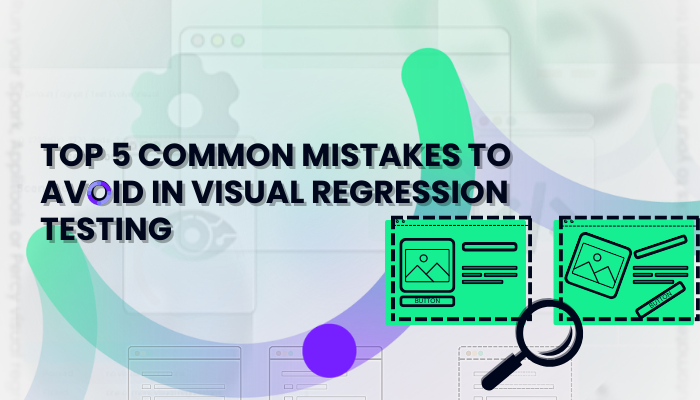Visual Regression Testing is an indispensable tool for maintaining a consistent and error-free user interface (UI) across web and mobile applications. However, even experienced teams stumble by falling into common traps that severely affect the accuracy and usefulness of their tests. Whether you’re new or seasoned, understanding these pitfalls can save you a ton of debugging hours, stress, and unexpected website glitches.
In this article, we will walk through the top five common mistakes in Visual Regression Testing. Plus, you’ll learn how to sidestep them smartly and maintain a flawless user experience.
What is Visual Regression Testing?
Visual Regression Testing is a specialized technique that captures and compares screenshots of web pages or applications over time to detect any unintended visual changes. Unlike traditional functional testing, this approach zeros in on appearance — fonts, layouts, colors, button placements, and much more.
By automatically flagging even pixel-level discrepancies, Visual Regression Testing ensures that code updates, third-party integrations, or browser changes don’t sneak in UI bugs unnoticed.
Not Setting a Proper Visual Baseline
Without a solid initial baseline, your Visual Regression Testing is like shooting arrows in the dark. A baseline is the “expected” visual snapshot against which future versions are compared.
Why this matters:
-
Inconsistent baselines lead to false positives.
-
Missed UI updates could confuse your users.
How to avoid it:
-
Establish a clear, reviewed, and approved baseline for each component and page state.
-
Update your baseline only after intentional UI changes are deployed and validated.
Overlooking Cross-Browser and Cross-Device Variability
One glaring error in Visual Regression Testing is assuming that a test passed in one browser automatically means success everywhere else.
Key problems caused:
-
Different browsers render fonts, shadows, and borders slightly differently.
-
Mobile and tablet views often have spacing and alignment variations.
Practical tips to solve this:
-
Always run Visual Regression Testing across a variety of browsers and devices.
-
Use tools that allow viewport emulations to spot layout inconsistencies easily.
Remember: Testing only on Chrome is like trying to fly with one wing — it won’t end well!
Neglecting Dynamic Content and Animations
If your website or app has carousels, pop-ups, animations, or dynamically loaded content, Visual Regression Testing can go haywire.
Issues you may face:
-
Flaky test results.
-
Frequent false positives.
-
Difficulty spotting real regressions amidst noise.
Strategies to manage dynamic elements:
-
Freeze animations during screenshot captures.
-
Mask or ignore dynamic sections that are not critical to your tests.
-
Introduce wait times to ensure all content is loaded before capturing screenshots.
Bullet points for better handling:
-
Use
disableAnimationsoptions in testing frameworks. -
Configure “masking regions” for ad banners or timers.
Running Visual Regression Tests Only After Development
Too often, Visual Regression Testing is treated as an afterthought — run only once after the feature is developed or just before release. That’s risky.
What’s the downside?
-
Late discovery of visual bugs.
-
Increased cost and effort to fix issues after integration.
Adopt this approach instead:
-
Integrate Visual Regression Testing into your Continuous Integration (CI) pipelines.
-
Perform checks early (Shift Left Testing) during the development phase itself.
This proactive stance helps you catch and fix visual anomalies before they snowball into bigger headaches.
Failing to Properly Manage Baseline Updates
Baseline management is a delicate dance. Carelessly updating baselines without vetting can legitimize bugs rather than exposing them.
Consequences of poor baseline handling:
-
Permanent masking of real issues.
-
Disrupted user experience with unnoticed visual defects.
Proven techniques to master baseline updates:
-
Use version control for baseline images.
-
Mandate manual review before accepting new baselines.
-
Document every baseline update reason clearly.
Best Practices for Effective Visual Regression Testing
Beyond avoiding mistakes, embracing solid strategies can take your Visual Regression Testing to the next level:
-
Modular testing: Test isolated UI components before full pages.
-
Threshold tolerance: Set acceptable pixel difference thresholds.
-
Incremental Testing: Only re-test parts of the UI that changed.
-
Clear reporting: Generate detailed, human-readable difference reports.
When in doubt, always think: “Am I making the tests easier to trust and faster to interpret?”
If You Need Automated Visual Regression Testing, Try TestEvolve
If setting up robust, scalable automated Visual Regression Testing feels overwhelming, don’t sweat it. TestEvolve offers an exceptional suite of visual testing features:
-
Use TestEvolve Spark for intuitive UI regression checks.
-
Seamlessly integrate with industry-leading tools like Applitools Eyes and Percy.
With TestEvolve, incorporating Visual Regression Testing into your project becomes a breeze — whether for single pages or an entire application workflow!
To Wrap Up
Visual Regression Testing is not just a luxury — it’s a vital shield against silent UI disasters. By recognizing and steering clear of common mistakes like weak baselines, browser biases, neglecting dynamic content, and late-stage testing, you can significantly improve your site’s visual reliability and user trust.
Taking the right steps early and embedding best practices into your workflow can save enormous time and protect your brand’s reputation. And remember, if you’re looking for a powerful solution, TestEvolve stands ready to make Visual Regression Testing easy, accurate, and scalable.
For Read More Articles You Can Explore This Website : regic.net



